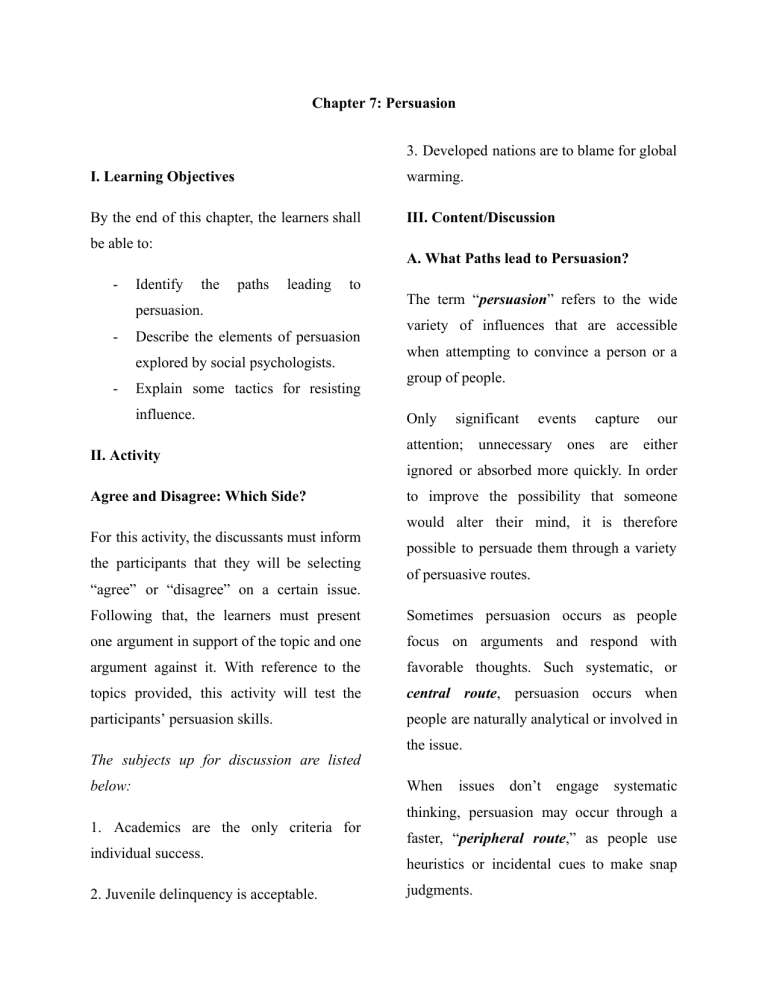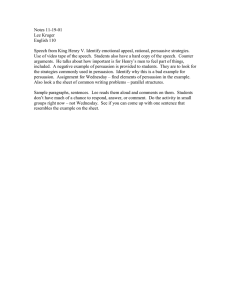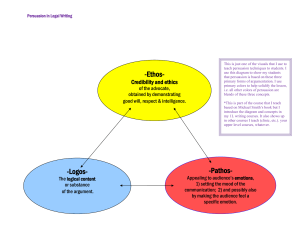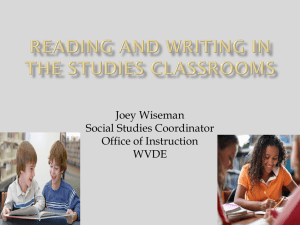
Chapter 7: Persuasion 3. Developed nations are to blame for global I. Learning Objectives warming. By the end of this chapter, the learners shall III. Content/Discussion be able to: - Identify A. What Paths lead to Persuasion? the paths leading to persuasion. - Describe the elements of persuasion explored by social psychologists. - Explain some tactics for resisting influence. II. Activity Agree and Disagree: Which Side? For this activity, the discussants must inform the participants that they will be selecting “agree” or “disagree” on a certain issue. The term “persuasion” refers to the wide variety of influences that are accessible when attempting to convince a person or a group of people. Only significant attention; events unnecessary capture our ones are either ignored or absorbed more quickly. In order to improve the possibility that someone would alter their mind, it is therefore possible to persuade them through a variety of persuasive routes. Following that, the learners must present Sometimes persuasion occurs as people one argument in support of the topic and one focus on arguments and respond with argument against it. With reference to the favorable thoughts. Such systematic, or topics provided, this activity will test the central route, persuasion occurs when participants’ persuasion skills. people are naturally analytical or involved in The subjects up for discussion are listed below: 1. Academics are the only criteria for individual success. 2. Juvenile delinquency is acceptable. the issue. When issues don’t engage systematic thinking, persuasion may occur through a faster, “peripheral route,” as people use heuristics or incidental cues to make snap judgments. Different Paths for Different Purposes Central route persuasion, agrees with, which makes you seem smart. being more thoughtful and less superficial, is more durable and more likely to influence behavior. Speaking style. Another way to appear credible is to speak confidently and fluently. Perceived trustworthiness. We are more willing to listen to a communicator we trust. Lastly, attractiveness and liking. Research B. What are the Elements of Persuasion? found that we’re more likely to respond to those we like. Among the ingredients of persuasion explored by social psychologists are these four: (1) the communicator, (2) the message, (3) how the message is communicated, and (4) the audience. In other words, who says b) What Is Said? The Message Content It matters not only who says something but also what that person says. what, by what method, to whom? REASON VERSUS EMOTION a) Thoughtful, involved audiences often travel Who Says? The Communicator Social psychologists have found that who is saying something does affect how an audience receives it. Credible People more responsive to reasoned arguments. Uninterested audiences more often travel the peripheral route; they are more affected by communicators persuasive. the central route to persuasion; they are tend who to be speak unhesitatingly, who talk fast, and who look listeners straight in the eye seem more credible. An attractive communicator is especially effective on matters of taste and personal values. their liking of the communicator (Chaiken, 1980; Petty et al., 1981). It also matters how people’s attitudes were formed. When people’s initial attitudes are formed primarily through the peripheral route, they are more persuaded by later peripheral, emotional appeals; when their Here are some characteristics of an effective initial attitudes are formed primarily through communicator: (perceived the central route, they are more persuaded expertise and trustworthiness). One way is by later information-based, central route to begin by saying things the audience arguments. Credibility THE EFFECT OF GOOD FEELINGS Messages also become more persuasive through association with good feelings, such as what often accompanies munching food or hearing pleasant music. Good feelings often enhance persuasion, partly by enhancing positive thinking and partly by linking good feelings with the message (Petty et al., 1993). THE EFFECT OF AROUSING FEAR more likely to do a small favor if they are asked to do a big favor first (the door-in-the-face technique) and are more likely to agree to a big favor if they agree to a small favor first (the foot-in-the-door phenomenon). ONE-SIDED VERSUS TWO-SIDED APPEALS How discrepant a message should be from an audience’s existing opinions depends on the communicator’s credibility. And whether Messages can also be effective by evoking a one- or two-sided message is more negative emotions. Experiments show that, persuasive depends on whether the audience often, the more frightened and vulnerable already agrees with the message, is unaware people feel, the more they respond (de Hoog of opposing arguments, and is unlikely later et al., 2007; Robberson & Rogers, 1988; to consider the opposition. Different people Tannenbaum, 2013). travel different avenues to persuasion. For optimists, positive persuasion works best. Playing on fear works best if a message For pessimists, negative persuasion is more leads people not only to fear the severity and effective (Geers et al., 2003). likelihood of a threatened event but also to perceive a solution and feel capable of implementing it (Devos-Comby & Salovey, 2002; Maddux & Rogers, 1983; Ruiter et al., 2001). MESSAGE CONTEXT PRIMACY VERSUS RECENCY When two sides of an issue are included, the primacy effect often makes the first message more persuasive. If a time gap separates the presentations, the more likely result will be a recency effect in which the second message The context of your message especially what prevails. immediately precedes it can make a big difference in how persuasive it is. People are CHANNEL OF COMMUNICATION - Refers to the way the message is - delivered. - For Messages are best comprehended and recalled when written. persuasion, there communication, must and be for The influence of adults on children - Communication flows from adults to communication, there must be a children—although as most parents channel. and teachers can tell you, getting them to listen is not always easy. Active experience or passive reception - Written and visual appeals are both THE AUDIENCE passive, How old are they? and thus have smaller hurdles to overcome. - - Active experience also strengthens relationships. When we act, we correlate with their age. - amplify the idea behind what we’ve done, especially when we feel People’s social and political attitudes Life cycle explanation – attitudes change as people grow older. - responsible. Generational explanation – attitudes do not change. Older people largely hold onto the attitudes they adopted MEDIA INFLUENCE - Do not underestimate the power of when they were young. - Attitudes of older people usually the media. show less change than do those of Those who personally influence our young people. opinions must get their ideas from some source, and often their sources are the media. What are they thinking? - Our minds are not sponges that soak up whatever pours over them. If a COMPARING MEDIA - message summons favorable Studies comparing different media thoughts, it persuades us. If it found that the more lifelike the provokes us to think of contrary medium, the more persuasive its arguments, we remain unpersuaded.. message. - Stimulating thinking makes strong - Attitude inoculation – exposing messages more persuasive and weak people to weak attacks upon their passages less persuasive. attitudes so that when stronger attacks HOW CAN PERSUASION BE come, they will have refutations available. RESISTED - It is easier to accept persuasive REAL-LIFE messages than to doubt them. INOCULATION PROGRAMS To understand an assertion is to supplemented once actively undoes the initial, training, reduce teen smoking. - Most strategies undoing, the acceptance lingers. pressure. PERSONAL COMMITMENT Before other efforts for life-skill emphasize resisting social Inoculating children against the influence of advertising encountering judgments, make commitment to Having by newer If a distracting event prevents the STRENGTHENING - Inoculation procedures, sometimes believe it—at least temporarily, until automatic acceptance. - - APPLICATION: stood others’ a your up - public 8 years: position. for Children, especially those under age ➢ Have trouble distinguishing your commercials from programs convictions, you will become less and susceptible to what others have to persuasive intent say. fail to grasp their ➢ Trust television advertising rather indiscriminately DEVELOPING COUNTER ARGUMENTS - Even weak arguments will prompt counter arguments which are then available for a stronger attack. IMPLICATIONS OF ATTITUDE INOCULATION - The best way to build resistance to brainwashing probably is not just stronger indoctrination into one’s current beliefs. If parents are worried that - their children might start 3. When issues don’t engage systematic thinking, persuasion may occur smoking, they might better teach through a faster, __________, as their people use heuristics or incidental children how to counter persuasive appeals about smoking. cues Paradoxically, one way to strengthen (peripheral route) existing attitudes is to challenge to make snap judgments. 4. ___________ refers to the way the them, although the challenge must message is delivered. (The Channel not be so strong as to overwhelm of Communication) them. 5. When two sides of an issue are IV. Learning Activities: 1. What do you think about the active experience included, the __________ often makes more the first message persuasive. (primacy effect) or passive reception? 2. How do you feel about the concept of 1. It is easier to accept persuasive attitude inoculation? 3. What do communication Part II. True or False you think about the flow from adults to children? messages than to doubt them. ( True) 2. Before encountering others’ judgments, do not make a public commitment to your position. ( False V. Assessment: Part I. Identification 1. __________ refers to the wide variety of influences that are accessible when attempting to ) 3. Our minds are not sponges that soak up whatever pours over them. ( True) 4. If a distracting event prevents the convince a person or a group of undoing, the acceptance lingers. ( people. (Persuasion) True) 2. Such systematic, or __________, 5. Most newer efforts do not emphasize persuasion occurs when people are strategies naturally analytical or involved in pressure. the issue. (central route) ( False ) for resisting social VI. References Guy-Evans, O. (2022). Central Route to Persuasion: Definition & Examples. Simply Psychology. October 23, Retrieved 2022 on from www.simplypsychology.org/central-route -to-persuasion.html Myers, D., & Tenge, J. (2015). Social Psychology Education. (12th ed.). McGraw-Hill




